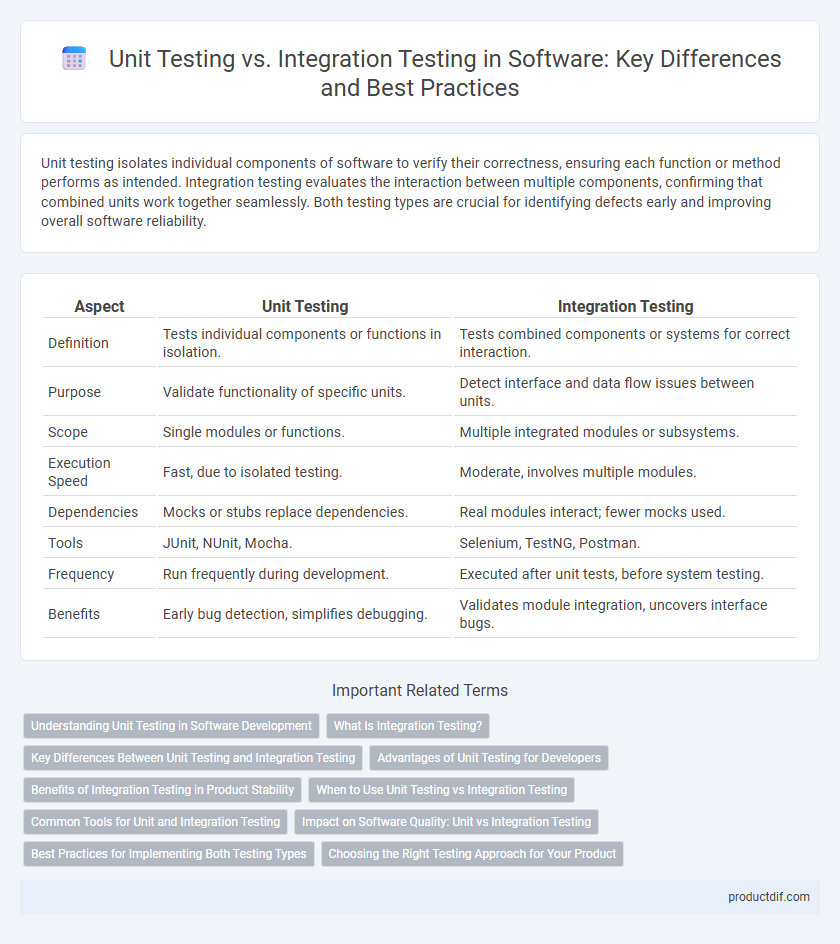Unit testing isolates individual components of software to verify their correctness, ensuring each function or method performs as intended. Integration testing evaluates the interaction between multiple components, confirming that combined units work together seamlessly. Both testing types are crucial for identifying defects early and improving overall software reliability.
Table of Comparison
| Aspect | Unit Testing | Integration Testing |
|---|---|---|
| Definition | Tests individual components or functions in isolation. | Tests combined components or systems for correct interaction. |
| Purpose | Validate functionality of specific units. | Detect interface and data flow issues between units. |
| Scope | Single modules or functions. | Multiple integrated modules or subsystems. |
| Execution Speed | Fast, due to isolated testing. | Moderate, involves multiple modules. |
| Dependencies | Mocks or stubs replace dependencies. | Real modules interact; fewer mocks used. |
| Tools | JUnit, NUnit, Mocha. | Selenium, TestNG, Postman. |
| Frequency | Run frequently during development. | Executed after unit tests, before system testing. |
| Benefits | Early bug detection, simplifies debugging. | Validates module integration, uncovers interface bugs. |
Understanding Unit Testing in Software Development
Unit testing in software development isolates individual components or functions to verify their correctness independently from the rest of the application. This method helps developers identify bugs early by testing specific code logic, ensuring that each unit meets its design and behaves as expected. Effective unit tests utilize frameworks like JUnit for Java or NUnit for .NET, facilitating automated and repeatable testing processes that enhance code quality and maintainability.
What Is Integration Testing?
Integration testing evaluates the interaction between multiple software modules to ensure they work together as expected within a system. It verifies data flow, communication, and functionality across integrated components, detecting interface defects that unit testing might miss. This test phase bridges isolated unit tests and full system testing, providing critical validation of combined module behavior.
Key Differences Between Unit Testing and Integration Testing
Unit testing focuses on verifying the functionality of individual components or functions in isolation, ensuring that each unit performs as expected. Integration testing evaluates the interactions between combined modules, detecting interface defects and issues in data flow across integrated units. While unit tests are typically automated and fast, integration tests require a broader setup to validate end-to-end communication within the software system.
Advantages of Unit Testing for Developers
Unit testing enables developers to identify and fix bugs early in the development cycle, improving code quality and reducing debugging time. It promotes modular coding practices, making code easier to maintain, refactor, and understand. Automated unit tests facilitate continuous integration by providing quick feedback on code changes, enhancing developer productivity and collaboration.
Benefits of Integration Testing in Product Stability
Integration testing enhances product stability by verifying the interaction between multiple software components, ensuring they work together as intended. It detects interface defects, data flow issues, and communication errors early, reducing the risk of system failures in production environments. This type of testing supports continuous delivery and maintains higher overall software quality by validating the seamless integration of modules.
When to Use Unit Testing vs Integration Testing
Unit testing is most effective during the early stages of software development to verify individual components or functions operate correctly in isolation. Integration testing should be employed after unit tests to assess how different modules or services interact and work together within the system. Choosing unit testing first helps identify localized bugs quickly, while integration testing uncovers issues in data flow and interfaces between components.
Common Tools for Unit and Integration Testing
Popular tools for unit testing include JUnit, NUnit, and pytest, which offer robust frameworks for testing individual components in isolation. For integration testing, tools like Selenium, Postman, and Spring Test facilitate testing the interaction between multiple components or services. Some frameworks, such as TestNG and Jest, support both unit and integration testing, enabling seamless transitions between testing scopes within a single environment.
Impact on Software Quality: Unit vs Integration Testing
Unit testing isolates individual components to identify and fix defects early, resulting in improved code quality and reduced debugging effort. Integration testing validates interactions between modules, ensuring system cohesion and uncovering interface-related issues that unit tests may miss. Combining both approaches enhances overall software quality by promoting reliability, maintainability, and functional correctness across the development lifecycle.
Best Practices for Implementing Both Testing Types
Unit testing requires isolating individual components using mocks and stubs to ensure precise validations and faster feedback loops. Integration testing emphasizes verifying interactions between modules, relying on realistic test environments and comprehensive test cases to detect interface defects. Combining automated test suites with continuous integration pipelines optimizes detection of both unit-level bugs and integration issues, improving software reliability.
Choosing the Right Testing Approach for Your Product
Unit testing targets individual components to ensure isolated functionality, making it ideal for identifying specific code errors early in development. Integration testing evaluates the interaction between combined modules, crucial for detecting interface and communication issues in complex systems. Selecting the appropriate testing approach depends on factors such as product complexity, development stage, and risk areas, balancing thorough coverage with efficient resource use.
Unit Testing vs Integration Testing Infographic

 productdif.com
productdif.com